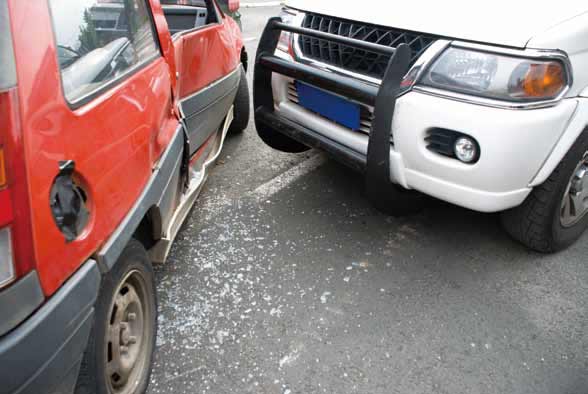ENFORCEMENT
 Red-light cameras, which include ones that take still photos and others that record video, are widely unpopular. However, red-light violations can be deadly. In 2009, 676 people were killed and an estimated 130,000 were injured in crashes that involved red-light running in the U.S. alone, according to the Insurance Institute for Highway Safety. Most red-light monitoring solutions are considered a way for traffic agencies to make a quick buck. However, independent audits of red-light enforcement have shown that while fines exceeded program costs in some jurisdictions, other programs did not break even.
Red-light cameras, which include ones that take still photos and others that record video, are widely unpopular. However, red-light violations can be deadly. In 2009, 676 people were killed and an estimated 130,000 were injured in crashes that involved red-light running in the U.S. alone, according to the Insurance Institute for Highway Safety. Most red-light monitoring solutions are considered a way for traffic agencies to make a quick buck. However, independent audits of red-light enforcement have shown that while fines exceeded program costs in some jurisdictions, other programs did not break even.
Speed cameras are another enforcement tool, which cuts average speeds by 1 to 15 percent, compared to sites without them, according to a 2010 review by the Cochrane Collaboration. The percentage of speeding vehicles fell by 14 to 65 percent at locations with speed cameras. Reducing speed makes a difference in passenger safety, even if the effect is not always noticeable. In some cases, speed cameras can increase congestion, due to drivers slowing down while passing a monitored stretch of road. “The Dutch police don't use fixed speed cameras — they use mobile speed cameras mounted in police cars,” said Peter de Konink, Product Line Manager for Codecs and Analytics, Siqura (a TKH Group company)
A good enforcement system must be able to stand up to scrutiny under dispute. “Images have to be tamperproof, and enforcement-based instrumentation and measurement other than presence detection need to be well-calibrated and have acceptable tolerances,” Ng said. “There should not be any ambiguity of the violation at the point of offence, and sometimes a secondary verification means may also be required.”
Some enforcement policies are designed to keep cars out, creating an environmental zone in crowded areas. “Classification of vehicles helps to facilitate this and to enforce the ‘green zone,'” said Koen Hobbelink, Business Development Manager of the Netherlands for Nedap. In the Dutch cities of Zaandam and Maastricht, bollards and LPR enforce restrictions on vehicular access to inner-city areas.
However, having multiple operators makes enforcement more difficult. The monitoring is mostly done by the contractor, while enforcement is carried out by a government agency or law enforcement, Ma said. The interaction between the two is often lacking, resulting in a gap.
OTHER CONSIDERATIONS
Along with technical considerations, operators will look at other factors. “One factor is clearly price,” Cartwright said. “Another consideration is whether the supplier can offer good maintenance support. There is also the nontechnical question of whether the operators have these skills.”
LOCAL REGULATIONS
Traffic-monitoring and management regulations are fairly local and aimed at a regional market. “In the Netherlands, Crow and Connekt are active,” Hobbelink said. “In other countries in Europe, other regulations might apply, but similar processes can be expected.”
Pan-European standards such as ERTICO are developed by Intelligent Transport Systems (ITS), which also has branches in the U.S. and Japan. Connekt is the Dutch organization for ITS, which connects parties to work on mobility in the Netherlands, Hobbelink said. China is developing traffic standards through its national standards committee, along with an intelligent transportation committee, Ma said. For now, standards are incomplete, out-of-date or overly specific.
In the U.K., the Urban Traffic Management and Control initiative began in the 1990s as a governmentsponsored research program. It looked at the breadth of modern technology for traffic monitoring, Cartwright said. But the initiative rapidly turned into interoperability as the key, using mainstream technology standards such as IP ones.
However, mainstream standards may not meet security needs. “We are a patchwork quilt industry — we get bits and pieces from entertainment, telecoms and IT,” said Dave Gorshkov, CEO of Digital Grape. “H.264 is talked of as a standard, but it's the most varied compression standard I've ever seen, with variations in I, P and B frames.” Traffic surveillance did not develop a standard until 2008, when the Technical Standards Working Group for the American Public Transportation Association issued one for surveillance in transport.
Traffic managers want video surveillance to observe a situation. They may also want to review images frame by frame and in high resolution when they need to. When the system is not needed, they do not want overhead bandwidth or storage. “This drove the standards group to put together a document that outlines good practice in use of the systems in various applications, giving ideal frame rates and minimum resolutions that need to be used in case you need to review the images,” Gorshkov said. “The document also guides operators and system purchasers through the design review process and acceptance testing — another part of the video surveillance industry that tends to be subjective rather than empirical.”